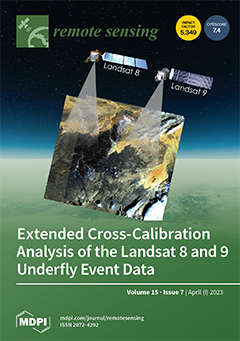Open AccessArticle
Data Comparison and Cross-Calibration between Level 1 Products of DPC and POSP Onboard the Chinese GaoFen-5(02) Satellite
by
Xuefeng Lei, Zhenhai Liu, Fei Tao, Hao Dong, Weizhen Hou, Guangfeng Xiang, Lili Qie, Binghuan Meng, Congfei Li, Feinan Chen, Yanqing Xie, Miaomiao Zhang, Lanlan Fan, Liangxiao Cheng and Jin Hong
Cited by 1 | Viewed by 1605
Abstract
The Polarization CrossFire (PCF) suite onboard the Chinese GaoFen-5(02) satellite has been sophisticatedly composed by the Particulate Observing Scanning Polarimeter (POSP) and the Directional Polarimetric Camera (DPC). Among them, DPC is a multi-angle sequential measurement polarization imager, while POSP is a cross-track scanning
[...] Read more.
The Polarization CrossFire (PCF) suite onboard the Chinese GaoFen-5(02) satellite has been sophisticatedly composed by the Particulate Observing Scanning Polarimeter (POSP) and the Directional Polarimetric Camera (DPC). Among them, DPC is a multi-angle sequential measurement polarization imager, while POSP is a cross-track scanning simultaneous polarimeter with corresponding radiometric and polarimetric calibrators, which can theoretically be used for cross comparison and calibration with DPC. After the data preprocessing of these two sensors, we first select local homogeneous cluster scenes by calculating the local variance-to-mean ratio in DPC’s Level 1 product projection grids to reduce the influence of scale differences and geometry misalignment between DPC and POSP. Then, taking the observation results after POSP data quality assurance as the abscissa and taking the DPC observation results under the same wavelength band and geometric conditions as the same ordinate, a two-dimensional radiation/polarization feature space is established. Results show that the normalized top of the atmosphere (TOA) radiances of DPC and POSP processed data at the nadir are linearly correlated. The normalized TOA radiance root mean square errors (RMSEs) look reasonable in all common bands. The DPC and POSP normalized radiance ratios in different viewing zenith angle ranges at different times reveal the temporal drift of the DPC relative radiation response. The RMSEs, mean absolute errors (MAEs), relative errors (REs), and scatter percentage of DPC degree of linear polarization (DoLP) falling within the expected error (EE = ±0.02) of POSP measured DoLP are better than 0.012, 0.009, 0.066, and 91%, respectively.
Full article
►▼
Show Figures





